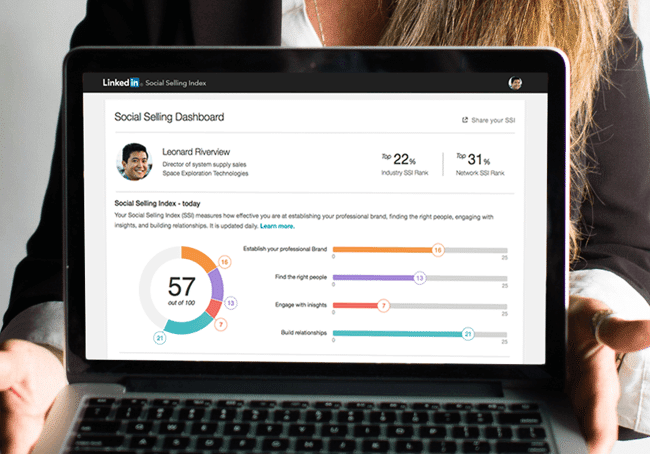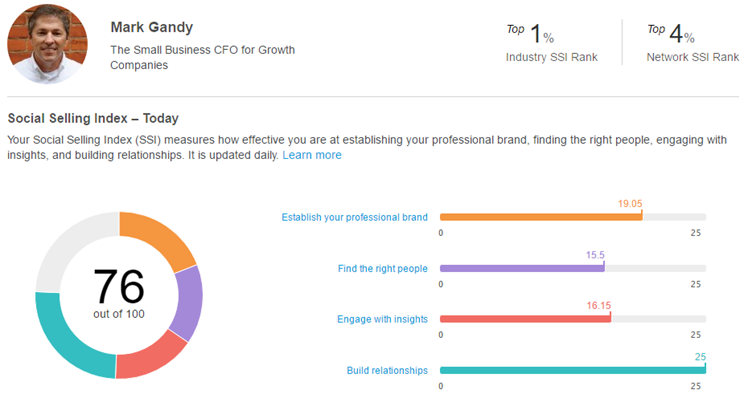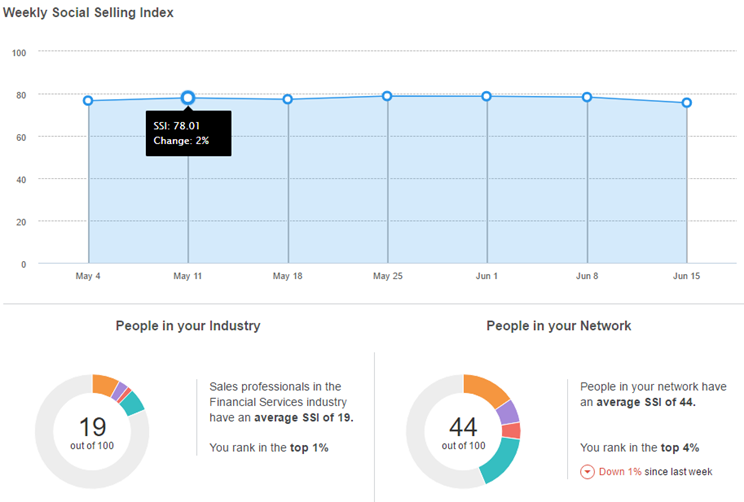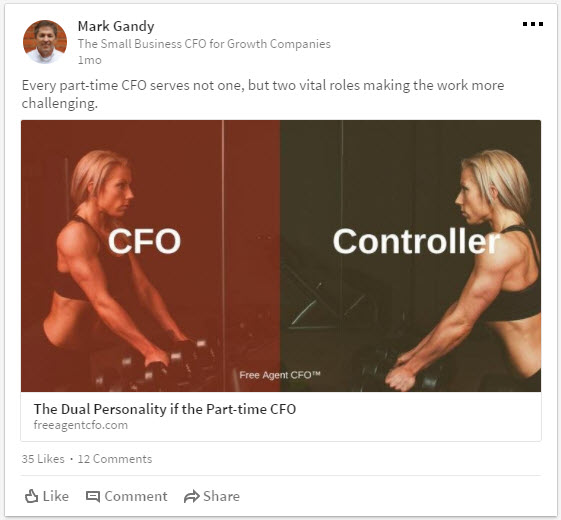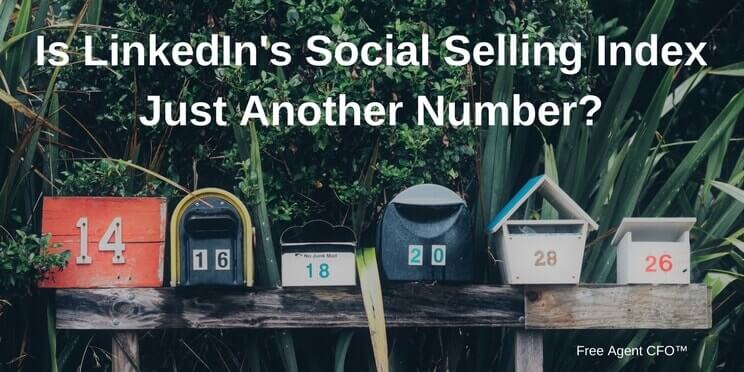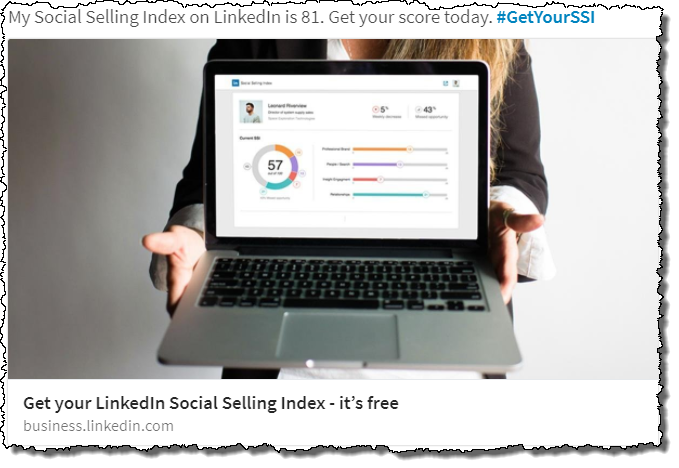Do You Know Your LinkedIn Social Selling Index?
Just what the doctor ordered, another index, another number allowing us to scale large mountains and to go where no professional has gone before.
Perhaps you know your number or maybe it’s new to you. In either case, I’ll explain how to obtain your LinkedIn Social Selling Index (SSI) and how to get the most out of this almost-meaningless number.
What Is the LinkedIn Social Selling Index?
According to LinkedIn, SSI measures the effectiveness of 1) establishing your brand, 2) finding the right people, 3) engaging your connections with meaningful information, and 4) building relationships.
If you do not have an SSI, you can obtain yours right now by entering your Email address on this page.
In just seconds, LinkedIn will provide your score such as the one below:
Key Drivers of SSI
Establish Your Professional Brand
I’m not going to reinvent the wheel. If you want to become an expert at LinkedIn and create a great profile (mine is pedestrian at best), Google is your best friend. I’m guessing there are hundreds and hundreds of articles on creating the perfect profile.
The only thing I’ll add here is to be yourself. Don’t try to be someone you are not. Be interesting and have someone review your profile. Here’s the good news–you can change it (just like I have about 50 times or so).
Find the Right People
There are two ways I find the right people. First, I go digging. For example, I find CEOs, founders, and owners in select locations using LinkedIn’s search feature. While I can use boolean search strings, I do a search on each title. I further refine my searches by selecting only second-degree connections.
My other method is to be cognizant of others in the groups I actively participate in.
Finding the right people is all about deciding ahead of time to whom you want to be connected to. Then go find those people.
Engage with Insights
Engaging with insights is as much an art as it is a science.
The main point is to share content that’s meaningful and clickable. Most of the time, I share my blog posts as a LinkedIn updates called posts. Sometimes I hit a home run and other times I strike out.
Recently, I compared and contrasted the CFO and controllership roles and then shared that post in my LinkedIn feed. After about two weeks, I had nearly 5,000 impressions on that update:
In other cases, some of my updates have bombed. Readers are fickle and busy. If you want people to read and click, the content has to stand out.
Engaging with insights is also about being helpful in groups, which I find frustrating. Several years ago, groups were great for meaningful conversations. Today, it’s crickets, or so it seems. Still, I try to be helpful in the 7-8 that I frequent regularly. Again, be helpful, not salesy.
Build Relationships
I think I can speak with authority on this key point. I have more than 1,500 connections. My last 200 or thereabouts connections have mostly been part-time CFOs because I apply a method for connecting to peers that works. My connect rate is pushing 60% for those I do not know.
Bottom line, you want to be connected to people you ultimately want to do business with or with connections where you can add value.
In your part-time CFO business, the majority of your connections should be with small business CEOs in your area. Do you serve a niche? You should be connected to Founders, CEOs, and COOs of those organizations too.
Finding the right people needs to be purpose driven. Don’t expect business overnight with this strategy. Over time you’ll see meaningful results that impact your practice directly and indirectly.
At the risk of shameless selling, I teach these principles in my coaching platform where I show my unique process to connecting to others. I even teach this process to my Gold-tier CFO clients. The process simply works.
Does the Score Matter?
Let’s assume your index is 25 or under and you’re wanting to gain clients through LinkedIn. In that case, you need help. That 25 is a great indicator that you’re falling short in most of the core areas of the SSI above.
Is your SSI just over 50? That’s a grey area. Maybe there are 1-2 areas where you need improvement. Since that is probably the case, just remember two things: 1) link with purpose and 2) share content to be helpful. Do those two things and the numbers will take care of themselves (both your new connections and your Social Selling Index).
Be Careful About Promoting This Index
I recently came across a CFO LinkedIn update revealing that he had an 80-something Social Selling Index. He included a link where a reader could get their score.
Really? Why?
I’m proud to say that I passed the CPA exam by scoring 75 on all four parts of the exam over two sessions. I studied the absolute minimum to achieve those scores. No. Check that. I crammed a few days before each session. The objective was not to get high scores. The primary aim was to pass.
With the Social Selling Index score, I don’t want a really high score. My goal is to be on LinkedIn no more than 5-10 minutes per week.
The score is not the main thing. The main thing is what you are trying to accomplish. My connection rate in LinkedIn is more than 60 percent. That’s insane. That’s because I use a process that simply works. And I keep dialing it in. I’m 99% certain that a 90 Index does not give me a greater connection rate.
Go ahead and publish an update about your score. But who cares what your score is? It’s just a number. Unless your score is under 50, there’s probably minimal correlation between your index and your strategic objectives on LinkedIn.
So let’s do this. Let’s see who has the best scores on metrics they are tracking who happens to have the very lowest Social Selling Index. That person is the real winner with their time.
